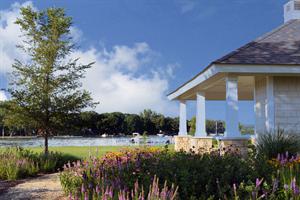 Two sisters—a builder and an academic specializing in universal design—have built a gold standard for accessible housing.
Two sisters—a builder and an academic specializing in universal design—have built a gold standard for accessible housing.
- By: Claire Easley, BuilderOnline.com
View the article and see a slideshow of pictures by clicking here.
The industry would be hard pressed to find a duo better suited to the task of creating the poster child for universally designed homes than the Tauke sisters. Susanne Tauke, owner of Hawthorn Woods, Ill.–based New American Homes, has been a home builder for 30 years. Her sister, Beth, is a professor of architecture at SUNY Buffalo and works with the university’s Center for Inclusive Design and Environmental Access (IDeA Center), a premier research center on universal design in the built environment.
So when they got the opportunity to team up on a universal design project house, they jumped at the chance. Their resulting brain child, the LIFEhouse—a 1,992-square-foot, ranch-style home near Antioch, Ill., that recently won the National Association of Home Builders’ Best of 50+ Housing Award—is a trifecta of beauty, brains, and accessibility.
“The home can comfortably accommodate a young family with a live-in elderly parent, disabled individuals, aging persons, or even a family with young children or whose adult children have come back home,” Beth says. “In other words, it is universally designed. It’s designed for everyone.”
But while its high accessibility makes the home notable, it’s the whisper-quiet incorporation of accessible features that makes it a show-stopper.
From the street, a ramp providing access to the front door is cleverly concealed by landscaping and a porch. Just inside the door, the plan includes a “memory niche”—cabinetry for dropping off keys, cellphones, and the like, that not only offers a quick spot to empty hands but also a go-to place for those with fading memories in search of their wallet.
And while the home features the standard, universal design offerings, such as lever door handles, extra-wide doorways and halls, and no-step entrances, it goes much further, starting with the layout as a whole. On the main level, the ultra-open plan provides minimal obstructions between the kitchen, living room, and den. The home office is a designated area against the wall of an extra-wide hallway, “or shall we call it a room?” Beth says. “The more open your plan can be, and if you’re thinking about those things up front, the more universally designed the house will be, just naturally.”
One of the points the Taukes make with the project is that a big part of universal design is preparing for the future by building homes that can be easily adapted should needs arise. “Three different times in my career I’ve had to take a house that I had done and make it accessible,” Susanne says. “One of my customers was in a debilitating car accident. Another had an allergic reaction that left her paralyzed. Things happen.”
And when they do, she says, it saves a lot of expense if bathroom walls are already prepped for grab bars and closets are stacked for quick conversion into an elevator shaft.
One element that no builder should ignore, Susanne and Beth agree, is lighting. “When you are dealing with issues of growing old, many more people have eyesight issues than mobility issues, and they happen much sooner.” Susanne says. “How many times have you not been able to read a recipe?”
The LIFEhouse responds with eight levels of lighting in the kitchen and at least four sources of light in other rooms. Even closets are outfitted with multiple levels of lighting fixtures, and rope lighting was installed inside the stair banister to illuminate the steps to the finished lower level. When entering and moving through the home, automatic lights illuminate the path to public spaces and the bedroom.
The home offers an elevator, but for those using the stairs, visibility is enhanced by alternating light- and dark-beige carpeting on treads, which Susanne says has been a hit far beyond the active adult set. “Young, old, and in between, they all love it!”
In the kitchen, countertops are staggered at three heights, one accessible from a seated position, one at standard counter height, and one extra tall—the result of IDeA Center research that found that one of the most common causes for kitchen injuries is bending over while cutting.
Similarly, two of the three bathrooms offer sinks at different levels, and a full-length mirror disguises a medicine cabinet that can be accessed by someone in either a seated or standing position.
But one idea that Susanne takes issue with is the claim that universal design is cost-neutral.
“The academics say it doesn’t cost any more,” she says. “Yes it does. It does because you need to have more square footage and square footage costs money. However, not everyone needs every one of these features. The way I look at it is there are many things we can do that are cost effective or cost nothing at all. It just depends on what they need.”

 Two sisters—a builder and an academic specializing in universal design—have built a gold standard for accessible housing.
Two sisters—a builder and an academic specializing in universal design—have built a gold standard for accessible housing.